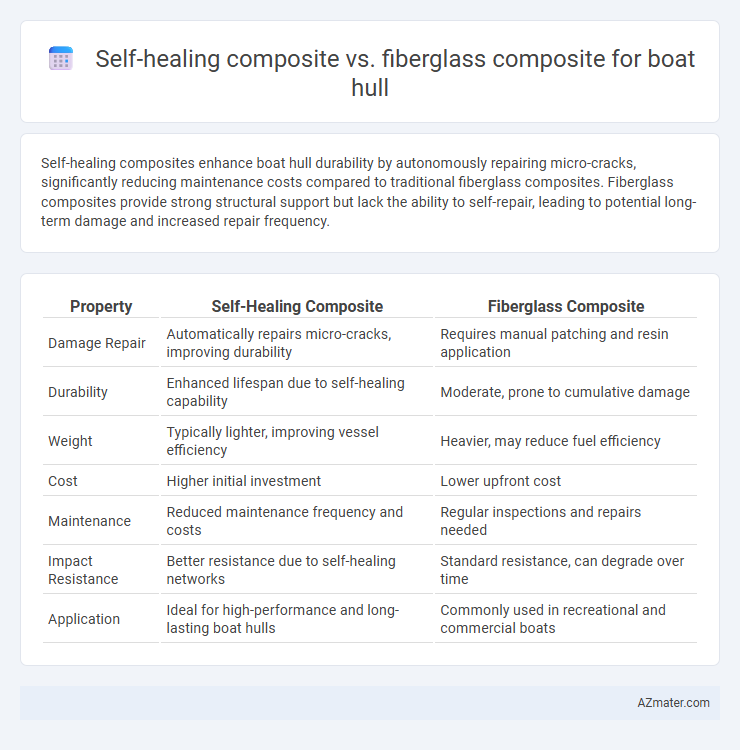Self-healing composites enhance boat hull durability by autonomously repairing micro-cracks, significantly reducing maintenance costs compared to traditional fiberglass composites. Fiberglass composites provide strong structural support but lack the ability to self-repair, leading to potential long-term damage and increased repair frequency.
Table of Comparison
| Property | Self-Healing Composite | Fiberglass Composite |
|---|---|---|
| Damage Repair | Automatically repairs micro-cracks, improving durability | Requires manual patching and resin application |
| Durability | Enhanced lifespan due to self-healing capability | Moderate, prone to cumulative damage |
| Weight | Typically lighter, improving vessel efficiency | Heavier, may reduce fuel efficiency |
| Cost | Higher initial investment | Lower upfront cost |
| Maintenance | Reduced maintenance frequency and costs | Regular inspections and repairs needed |
| Impact Resistance | Better resistance due to self-healing networks | Standard resistance, can degrade over time |
| Application | Ideal for high-performance and long-lasting boat hulls | Commonly used in recreational and commercial boats |
Introduction to Boat Hull Materials
Self-healing composites for boat hulls integrate microcapsules or vascular networks that release healing agents upon damage, enhancing durability and reducing maintenance compared to traditional materials. Fiberglass composites, widely used in marine applications, consist of glass fibers embedded in a resin matrix, offering strength, corrosion resistance, and cost-effectiveness but lack autonomous repair capabilities. The choice between self-healing and fiberglass composites impacts longevity, repair frequency, and overall performance of boat hulls in marine environments.
Overview of Self-Healing Composites
Self-healing composites for boat hulls incorporate microcapsules or vascular networks containing healing agents that activate upon damage, autonomously repairing cracks and enhancing durability. Unlike traditional fiberglass composites, which rely on external repairs after damage, self-healing materials improve vessel longevity and reduce maintenance costs by preventing water ingress and structural degradation. Key innovations in polymer chemistry and nanotechnology drive the efficiency of self-healing mechanisms, positioning these composites as advanced solutions for marine applications.
Overview of Fiberglass Composites
Fiberglass composites, composed of glass fibers embedded in a resin matrix, offer high strength-to-weight ratios and excellent corrosion resistance, making them a standard choice for boat hull construction. Their durability and ease of repair contribute to widespread use in marine applications, although they require regular maintenance to prevent water absorption and osmosis damage. Compared to self-healing composites, fiberglass composites lack autonomous damage repair capabilities but remain cost-effective and widely available for traditional boat-building methods.
Material Properties Comparison
Self-healing composites for boat hulls feature embedded microcapsules or vascular networks that release healing agents upon damage, significantly enhancing durability and reducing maintenance costs compared to traditional fiberglass composites. Fiberglass composites offer high tensile strength, excellent corrosion resistance, and cost-effectiveness but lack the ability to autonomously repair impact or fatigue damage, leading to potential structural weaknesses over time. The integration of self-healing mechanisms in composites provides superior resilience against microcracks and delamination, extending the service life and safety of marine vessels.
Durability and Longevity
Self-healing composites for boat hulls significantly enhance durability by autonomously repairing microcracks, reducing maintenance frequency and extending service life compared to traditional fiberglass composites. Fiberglass composites offer good strength and corrosion resistance but are prone to cumulative damage over time, leading to potential structural failures. The integration of self-healing mechanisms improves the longevity of boat hulls by maintaining integrity under environmental stress and mechanical fatigue.
Maintenance and Repair Ease
Self-healing composites for boat hulls significantly reduce maintenance frequency due to their ability to autonomously repair minor damages, enhancing long-term durability and cost efficiency. Fiberglass composites require regular inspections and manual repairs, often involving labor-intensive patching and curing processes, which can be time-consuming and expensive. The self-healing technology minimizes downtime and repair costs, making it an advanced alternative for marine applications where hull integrity is critical.
Performance and Safety Factors
Self-healing composites for boat hulls enhance safety by repairing minor damages autonomously, reducing the risk of structural failure and extending service life. In contrast, fiberglass composites, while strong and cost-effective, require manual repairs and are more prone to crack propagation under impact stress. Performance-wise, self-healing composites maintain hull integrity under dynamic marine conditions, offering superior durability compared to traditional fiberglass materials.
Cost and Accessibility
Self-healing composites for boat hulls often come with higher initial costs due to advanced materials and manufacturing processes, making them less accessible to budget-conscious builders. Fiberglass composites offer a more affordable and widely available solution, supported by established supply chains and industry familiarity. Cost efficiency and ease of procurement make fiberglass composites the preferred choice for most boat hull applications.
Environmental Impact
Self-healing composites for boat hulls significantly reduce environmental impact by enhancing durability and minimizing waste through extended lifecycle and fewer repairs compared to traditional fiberglass composites. Fiberglass composites contribute to environmental pollution via non-biodegradable resin matrices and high-energy manufacturing processes, generating substantial carbon emissions and microplastic waste over time. Adoption of self-healing materials lowers resource consumption and marine pollution, offering a more sustainable alternative in marine vessel construction.
Future Prospects in Boat Hull Technology
Self-healing composites offer significant future potential in boat hull technology by enhancing durability and reducing maintenance costs through embedded microcapsules that autonomously repair cracks and damage. In contrast, fiberglass composites, while currently dominant due to their strength and cost-effectiveness, lack self-repair capabilities, leading to higher long-term repair expenses. Advancements in self-healing materials and nanotechnology are expected to revolutionize boat hull construction by extending service life and improving safety in marine environments.

Infographic: Self-healing composite vs Fiberglass composite for Boat hull
 azmater.com
azmater.com